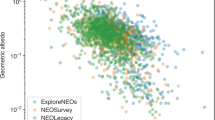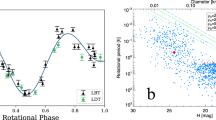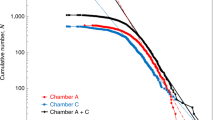Abstract
In the absence of a firm link between individual meteorites and their asteroidal parent bodies, asteroids are typically characterized only by their light reflection properties, and grouped accordingly into classes1,2,3. On 6 October 2008, a small asteroid was discovered with a flat reflectance spectrum in the 554–995 nm wavelength range, and designated 2008 TC3 (refs 4–6). It subsequently hit the Earth. Because it exploded at 37 km altitude, no macroscopic fragments were expected to survive. Here we report that a dedicated search along the approach trajectory recovered 47 meteorites, fragments of a single body named Almahata Sitta, with a total mass of 3.95 kg. Analysis of one of these meteorites shows it to be an achondrite, a polymict ureilite, anomalous in its class: ultra-fine-grained and porous, with large carbonaceous grains. The combined asteroid and meteorite reflectance spectra identify the asteroid as F class3, now firmly linked to dark carbon-rich anomalous ureilites, a material so fragile it was not previously represented in meteorite collections.
This is a preview of subscription content, access via your institution
Access options
Subscribe to this journal
Receive 51 print issues and online access
$199.00 per year
only $3.90 per issue
Buy this article
- Purchase on Springer Link
- Instant access to full article PDF
Prices may be subject to local taxes which are calculated during checkout




Similar content being viewed by others
References
Lauretta, D. S. & McSween, H. Y. Jr (eds) Meteorites and the Early Solar System II (Univ. Arizona Press, 2006)
Vernazza, P. et al. Compositional differences between meteorites and near-Earth asteroids. Nature 454, 858–860 (2008)
Tholen, D. J. in Asteroids II (eds Matthews, M. S., Binzel, R. P. & Gehrels, T.) 1139–1150 (Univ. Arizona Press, 1989)
Kowalski, R. A. et al. in MPEC 2008–T50 (ed. Williams, G. V.) 1–1 (Minor Planet Center, Smithsonian Astrophysical Observatory, 2008)
Yeomans, D. NASA/JPL Near-Earth Object Program Office Statement 〈http://neo.jpl.nasa.gov/news/news159.html〉 (6 October 2008)
Chesley, S., Chodas, P. & Yeomans, S. NASA/JPL Near-Earth Object Program Office Statement 〈http://neo.jpl.nasa.gov/news/2008tc3.html〉 (4 November 2008)
Pravec, P. et al. Tumbling asteroids. Icarus 173, 108–131 (2005)
Brown, P. G. US Government release: Bolide detection notification 2008–282 (15 October 2008); 〈http://aquarid.physics.uwo.ca/~pbrown/usaf/usg282.txt〉.
Borovicka, J. & Charvat, Z. 2008 TC_3. IAU Circ. No. 8994 (2008)
Swinbank, R. & O’Neill, A. A. A stratosphere-troposphere data assimilation system. Mon. Weath. Rev. 122, 686–702 (1994)
Elhassan, M., Shaddad, M. H. & Jenniskens, P. On the trail of 2008 TC3. (Astronomy Picture of the Day, NASA Goddard Space Flight Center, 8 November 2008); 〈http://apod.nasa.gov/apod/ap081108.html〉.
Clayton, R. N. & Mayeda, T. K. Oxygen isotope studies of achondrites. Geochim. Cosmochim. Acta 60, 2681–2708 (1996)
Goodrich, C. A., Van Orman, J. A. & Wilson, L. Fractional melting and smelting on the ureilite parent body. Geochim. Cosmochim. Acta 71, 2876–2895 (2007)
Mittlefehldt, D. W., McCoy, T. J., Goodrich, C. A. & Kracher, A. Non-chondritic meteorites from asteroidal bodies. Rev. Mineral. 36, 1–195 (1998)
Zolensky, M. et al. Andreyivanovite: A second new phosphide from the Kaidun meteorite. Am. Mineral. 93, 1295–1299 (2008)
Goodrich, C. A. Ureilites: A critical review. Meteoritics 27, 327–353 (1992)
Britt, D. T. & Consolmagno, S. J. Stony meteorite porosities and densities: A review of the data through 2001. Meteorit. Planet. Sci. 38, 1161–1180 (2003)
Pravec, P. & Harris, A. W. Binary asteroid population. I. Angular momentum content. Icarus 190, 250–259 (2007)
Brown, P., Spalding, R. E., ReVelle, D. O., Tagliaferri, E. & Worden, S. P. The flux of small near-Earth objects colliding with the Earth. Nature 420, 294–296 (2002)
Ceplecha, Z. et al. Meteor phenomena and bodies. Space Sci. Rev. 84, 327–471 (1998)
Brown, P. G., ReVelle, D. O., Tagliaferri, E. & Hildebrand, A. R. An entry model for the Tagish Lake fireball using seismic, satellite and infrasound records. Meteorit. Planet. Sci. 37, 661–675 (2002)
Gaffey, M. J. et al. Mineralogic variations within the S-type asteroid class. Icarus 106, 573–602 (1993)
Sandford, S. A. The mid-infrared transmission spectra of Antarctic ureilites. Meteoritics 28, 579–585 (1993)
Hiroi, T., Zolensky, M. E. & Pieters, C. M. Discovery of the first D-asteroid spectral counterpart: Tagish Lake meteorite. Lunar Planet. Sci. Conf. 32, abstr. 1776 (2001)
Tholen, D. J. Asteroid Taxonomy from Cluster Analysis of Photometry. Ph.D. Thesis, Univ. Arizona (1984)
Zellner, B., Tholen, D. J. & Tedesco, E. F. The eight-color asteroid survey: Results for 589 minor planets. Icarus 61, 335–416 (1985)
Bell, J. F. Mineralogical clues to the origins of asteroid dynamical families. Icarus 78, 426–440 (1989)
Acknowledgements
We thank the University of Khartoum for support of the field campaigns, and students and staff of the Physics Department of the Faculty of Sciences for their efforts to recover the meteorites. P.J. is supported by the NASA Planetary Astronomy program. D.R. acknowledges the support of NASA's Cosmochemistry program (grant NNX07AI48G). A. Alunni, J. Travis-Garcia and L. Hofland of NASA Ames Research Center, and J. Herrin of NASA Johnson Space Flight Center, provided laboratory assistance. The work conducted at JPL/Caltech was under contract with NASA. The William Hershel Telescope is operated on the island of La Palma by the Isaac Newton Group in the Spanish Observatorio del Roque de los Muchachos of the Instituto de Astrofísica de Canarias.
Author Contributions P.J., M.H.S., D.N., S.E. and A.M.K. led the field search for meteorites. M.E.Z., L.L. and G.A.R. performed the petrographic analysis. J.M.F. performed the trace element bulk chemistry analysis. D.R. performed the oxygen isotope analysis. A.S. performed the Raman analysis. S.R.C. calculated the orbit and ground track. A.F., S.D., H.H.H. and G.R. observed and analysed the astronomical spectrum. P.G.B. analysed the infrasound data. P.G.B., W.N.E. and P.J. performed dark-flight calculations. S.P.W., E.T., M.B.B. and R.E.S. facilitated and analysed the US Government satellite observations. R.D. and M.K. observed the asteroid light curve, which was analysed by P.P., J.B. and Z.C. analysed the Meteosat 8 observations. P.J. and J.V. investigated the link with possible other parent bodies. J.K. provided wind model data. J.A. and P.J. analysed train wind drift. J.L.B. and P.J. measured reflection spectra of the meteorite. R.L.M. and P.J. obtained optical imaging of the meteorite. S.A.S., S.N.M., M.N. and P.J. performed the mid-infrared analysis.
Author information
Authors and Affiliations
Corresponding author
Supplementary information
Supplementary Information
This file contains Supplementary Notes, Supplementary Figures S1-S2 with Legends, Supplementary Table S1 and Supplementary References (PDF 115 kb)
Rights and permissions
About this article
Cite this article
Jenniskens, P., Shaddad, M., Numan, D. et al. The impact and recovery of asteroid 2008 TC3. Nature 458, 485–488 (2009). https://doi.org/10.1038/nature07920
Received:
Accepted:
Issue Date:
DOI: https://doi.org/10.1038/nature07920
This article is cited by
-
Shapes, structures, and evolution of small bodies
Astrodynamics (2021)
-
Meteoritic evidence for a Ceres-sized water-rich carbonaceous chondrite parent asteroid
Nature Astronomy (2020)
-
Exploring the Bimodal Solar System via Sample Return from the Main Asteroid Belt: The Case for Revisiting Ceres
Space Science Reviews (2020)
-
Exogenic basalt on asteroid (101955) Bennu
Nature Astronomy (2020)
-
A unique CO-like micrometeorite hosting an exotic Al-Cu-Fe-bearing assemblage – close affinities with the Khatyrka meteorite
Scientific Reports (2019)
Comments
By submitting a comment you agree to abide by our Terms and Community Guidelines. If you find something abusive or that does not comply with our terms or guidelines please flag it as inappropriate.



